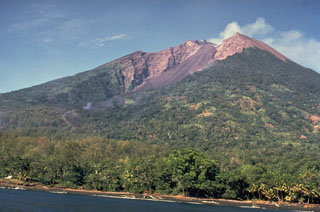Report on Manam (Papua New Guinea) — June 1980
Scientific Event Alert Network Bulletin, vol. 5, no. 6 (June 1980)
Managing Editor: David Squires.
Manam (Papua New Guinea) Activity declines to ocasional ash emission
Please cite this report as:
Global Volcanism Program, 1980. Report on Manam (Papua New Guinea) (Squires, D., ed.). Scientific Event Alert Network Bulletin, 5:6. Smithsonian Institution. https://doi.org/10.5479/si.GVP.SEAN198006-251020
Manam
Papua New Guinea
4.08°S, 145.037°E; summit elev. 1807 m
All times are local (unless otherwise noted)
"Manam's activity returned to a lower level in June. Occasional brown or grey ash emissions from Southern crater were observed, and light grey emissions from Main crater were seen on 5 June. However, no explosive sounds and no glows were observed from either crater. No trends were registered by the tiltmeters, and seismicity remained at its normal level."
Geological Summary. The 10-km-wide island of Manam, lying 13 km off the northern coast of mainland Papua New Guinea, is one of the country's most active volcanoes. Four large radial valleys extend from the unvegetated summit of the conical basaltic-andesitic stratovolcano to its lower flanks. These valleys channel lava flows and pyroclastic avalanches that have sometimes reached the coast. Five small satellitic centers are located near the island's shoreline on the northern, southern, and western sides. Two summit craters are present; both are active, although most observed eruptions have originated from the southern crater, concentrating eruptive products during much of the past century into the SE valley. Frequent eruptions, typically of mild-to-moderate scale, have been recorded since 1616. Occasional larger eruptions have produced pyroclastic flows and lava flows that reached flat-lying coastal areas and entered the sea, sometimes impacting populated areas.
Information Contacts: C. McKee, RVO.

